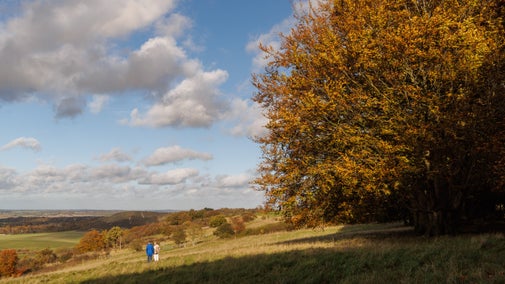Ivinghoe Hills butterfly walk
Essex, Bedfordshire & Hertfordshire
Follow this easy circular walk where you can spot the various species of butterflies found on the Ivinghoe Hills. Species to see include the rare Duke of Burgundy and other species that thrive on rough chalk downland, such as chalkhill blue, dark-green fritillary and marbled white butterflies.
Near to
Ashridge EstateStart point
National Trust Steps Hill lower car park on west side of C road (Beacon Road), grid ref: SP96415Trail information
Discover a variety of butterflies
The lower slopes of Ivinghoe Hills have one of the strongest colonies of Duke of Burgundy butterflies left in England. Also look out for dingy and grizzled skippers, brown argus and green hairstreaks.
More near here
Ashridge Estate
Ancient trees, rolling chalk downlands and lush meadows in an area of outstanding natural beauty

Bridgewater Monument to Pitstone Windmill circular walk
Oxfordshire, Buckinghamshire & BerkshireThe Bridgewater Monument to Pitstone Windmill circular walk combines two of the best reasons to visit the Ashridge Estate.

Get in touch
Moneybury Hill, Ringshall, Near Berkhamsted, Hertfordshire, HP4 1LT
Our partners

We’ve partnered with Cotswold Outdoor to help everyone make the most of their time outdoors in the places we care for.
You might also be interested in
Walking
Explore some of the finest landscapes in our care on coastal paths, accessible trails, woodland walks and everything in between. Find the best places to walk near you.

Walking in Essex, Bedfordshire and Hertfordshire
From long forest wanders to a gentle amble to a famous literary hut, these are some of the best walks around Essex, Bedfordshire and Hertfordshire.

Cotswold Outdoor: our exclusive walking partner
Learn about the National Trust’s ongoing partnership with Cotswold Outdoor. Find out how they help us care for precious places and the exclusive discount available for National Trust supporters.

Staying safe at National Trust places
The special places in National Trust care sometimes come with a few risks for visitors, be it coastline or countryside. Find out how to keep safe throughout your visits.

Follow the Countryside Code
Help to look after National Trust places by observing a few simple guidelines during your visit and following the Countryside Code.

Top tips for butterfly spotting
Discover how to spot butterflies without scaring them away, and find out which types of plants will attract them to your garden or green space.


